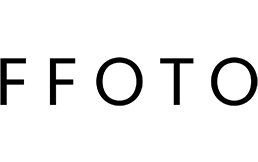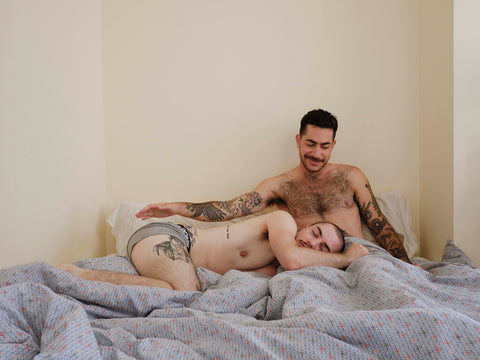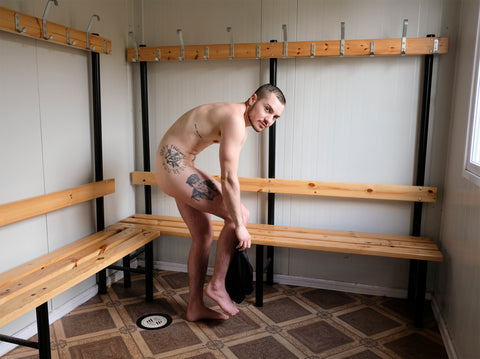In Conversation: Kyle Lasky and Wynne Neilly
Kyle Lasky and Wynne Neilly’s collaborative portrait series Have / Hold recently launched on FFOTO. The photographs are resonating with a wide audience thanks to the artists’ willingness to pull back the curtain to show uncommon views of platonic masculine intimacy; a concept that isn’t openly accepted in our society. The photographs are currently featured in the 2021 Scotiabank CONTACT Photography Festival in the exhibition “We Buy Gold” at Gallery TPW, curated by Michèle Pearson Clarke, Toronto’s Photo Laureate.
On March 31, I met with Lasky and Neilly via Zoom to talk about Have / Hold. The artists were keen to discuss how they developed this project alongside their other pursuits -- often finishing each other’s sentences. Our conversation touches on their longstanding friendship, the importance of vulnerability in their art practice, the role of social media in LGBTQ+ activism, and where they see their artistic partnership heading.
Watch Lasky and Neilly discuss the genesis of Have / Hold:
Craig D'Arville: It's great to talk to you both today on the International Transgender Day of Visibility. The timing is coincidental, but it got me excited that we're going to be talking today about Have / Hold, a work that is deeply centered in your personal experiences as trans people, and the message that you share through making that work. I was going to ask later on in the interview if these art works are centered in activism, but with today being International Transgender Day of Visibility, that helped me process the idea that just being a visible, unapologetic trans person is itself activism in 2021. Would you agree with that assessment?
Kyle Lasky: I definitely agree, I think that for both Wynne and I everything that we do comes from a place of “furthering the gay agenda”. And yes, you're right; our existence and our proud showcasing of our lives is a form of activism. It's also just what's normal and true and real to us.
Wynne Neilly: Yeah, I mean, whether we want this work to be political or not, I think we are at a state in our culture and society where it is and it has to be, or else things are never going to change.
Craig D'Arville: Kyle, your 9-to-5 job, along with your fine art practice, is very much inline with a grass-roots approach to community activism. Can you talk about how these aspects of your creative life complement each other?
Kyle Lasky: In my day-to-day career I work in communication design and I'm working with progressive nonprofits who I'm politically aligned with for the most part. And in my extracurricular time, for example, I co-founded TranSanta, which is a social media campaign focused on supporting trans youth in need. So that, while I wasn't doing anything necessarily artistic, or what you would frame as artistic, I was kind of the architect behind the project and it's the same sort of work. It's trying to use my skills to benefit people within my community that need a little bit of support in some way or another.
Craig D'Arville: Wynne, you're having quite a moment. How are you processing all the attention that's coming your way since the release of your portrait of Elliot Page on the cover of TIME?
Elliot Page, photographed in 2021 by Wynne Neilly for TIME
Wynne Neilly: It has been challenging for sure. I could not have predicted all the ways that the attention, the different streams of media, that I ended up seeing myself or my work on. It's just been kind of overwhelming to be honest. Not necessarily in a bad way, by any means, it's all good stuff that I have been wanting to participate in; it's just a lot, all in a very concentrated amount of time. So, I have really been trying to take it day by day. It's also a huge privilege to be able to see my work grow so quickly and reach far away places that I didn't imagine it could ever go. I think about what I was doing a year ago and imaging what I'm doing right now. It just blows my mind.
Craig D'Arville: Let's start talking about Have/Hold, the collaborative series that we’re offering, made by both of you, through FFOTO. You've been close friends for a long time. How did taking pictures of each other and together become a more considered official project? What led to this?
Wynne Neilly: Yeah, so it's a layered answer, as is our friendship. I mean, we started photographing each other when we met at Ryerson, just as practice, for fun, for projects, just exploring portraiture. Both being interested in community and the people around each other, we were subjects in each other's work and our friendship just continued to develop over the years. And we've always taken photos of each other, with each other, because we both have an art background, I think there's always an intent behind the photos we take of each other.
So I don't know, more recently we sort of... in the last couple of years, 2018 is when we shot the first iteration of Have/Hold and that was when we were like, "Okay, we are going to collaborate. We are going to do a body of work together. We don't know what it's going to be, but we have this opportunity, environment, space and time to do this, so let's do this."
2018 is when we first officially stamped it as something we were fulfilling together. But then, in the last couple of years we've really done a lot of reflecting on old images and re-contextualizing them and finding a bigger body of work out of it.
"Kyle Bums a Light Nos. 1 & 2", diptych, 2018
Kyle Lasky: Yeah, I'll add specifically what led to the development of Have / Hold. In 2018, we both went through really extreme breakups and coincidentally within 12 hours of each other, and at that point...
Wynne Neilly: Unknowingly.
Kyle Lasky: Yeah. Unknowingly, yeah. My relationship of six years and Wynne's relationship of, I think four, at time ended. Wynne has since reconnected and they're back together and going to be together forever.
But anyway, our worlds exploded at the same time. So, what an amazing opportunity for so many things -- including a trip. We planned to go to a few different countries. We went to Iceland, Spain, and France together. We knew we would be documenting everything and we just went into that saying, like Wynne said, "We want to collaborate on something. We want to make something together. We don't know what it is, so let's just overshoot and see what we have." And it became really clear that what we had ... What we were naturally creating were these moments ... We were capturing intimacy that we do share.
So we were creating these scenes that you see in the work that are just very intimate and also very real. We always share a bed if we're staying somewhere together. We opt to sleep in the same bed. We stay up late talking and laughing and we just want to be together. Like, if we're going to get ready to a gay bar in Barcelona, we're going to be in the bathroom at the same time getting ready. We are sharing these spaces. We are really close physically. So it just became so clear that that was what the project was about. It was about our intimacy and our vulnerability with each other with our bodies, and that that was something that is unique to see; two people who look like men and who aren't lovers sharing that kind of space.
 "Our Favourite Spot", 2018
"Our Favourite Spot", 2018
Craig D'Arville: Would it be appropriate then to say that the collaboration is a refuge for the two of you?
Kyle Lasky: Yeah, absolutely.
Wynne Neilly: Yeah.
Kyle Lasky: And it's a form of deepening our relationship as well.
Craig D'Arville: What is the general process in making these portraits? How much is spontaneous and how much is premeditated or planned?
Wynne Neilly: I think when we went into it and we started driving around all of Iceland -- hours and hours of driving and talking -- we just started listing off little dioramas that we could photograph. "Oh, what if we come across a river and we're in it and you're holding me over a" ... We're just imagining scenes that are performances of our intimacy, but they're not fake in any way. So it's a little bit of that, "Let's start with this type of scene and see what comes out of it," and then just spontaneous moments between us. So yeah, it's a little sprinkle of everything.
"Wynne's First Head Shave", 2018
Craig D'Arville: I think it's important to explore the process, because these photographs are your conversation; these are your deepest selves you’re showing, right?
Wynne Neilly: Well, the one thing that I want to add to that too is, because we have a good foot in the door in this project, we've developed it into phases at this point, so it feels more matured. And I'm thinking more about the types of scenes that I want to make and I feel like things that I suggest to Kyle, it's like we haven't done them together, but it also is this real and honest opportunity for us to be closer as well. So, it's like creating the intimacy for the project, but for the betterment of our relationship in general, if that makes sense.
Kyle Lasky: It's kind of like planning a date.
Wynne Neilly: Mm-hmm.
Kyle Lasky: You think you're going to take somebody dancing and you're imagining in your head what the night's going to look like and what you're going to do together. That's what we're doing. We're planning dates really.
Wynne Neilly: And then executing them together for ourselves and for each other, but also for the camera.
"Rest Stop", 2018
Craig D'Arville: So in a way, Have / Hold is like a proxy relationship in that it helps define how you relate to each other?
Wynne Neilly: I think in a way yeah, but also we are long-distance friends and more than half of our friendship now has been long distance. So when we are together in those photos, it is such an open vulnerability and intimacy because we have such limited time together. So when we are together, it's really like seizing the moment, I guess in that sense.
Craig D'Arville: Kyle, do you see Have / Hold as being an ongoing project for the two of you, or do you see an end date somewhere down the line?
Kyle Lasky: Definitely no end date. I mean, I think the title itself speaks to the intention behind the project. Wynne is family. We will always be in each other's lives. Like any relationship, I'm sure we will have ebbs and flows, but we will always be in each other's lives and that is a commitment that we've made and that is unwavering. And I think that presents us with this incredible opportunity to continue the project for the entirety of our lives. And as trans people, we will shift and change in a lot of ways, many of which will be physical, as we grow older, as our identities continue to move through different phases and that's going to be a really interesting part of this chronological documentation of our lives and our friendship over the decades.
"A Morning in Paris", 2018
Craig D'Arville: Through this project, you’re inviting public scrutiny. Is that something that you considered in making this work; that drawing of attention?
Kyle Lasky: Before we really intentionally started the project, we took and posted a lot of photos of each other and of ourselves together. And that was always within the bubble of our supportive social media community. I mean, many, many, many people that we don't know personally, but still people who are following our accounts or are engaging with the content we put out, because they are in alignment with us. But there was always an interesting sort of feedback from people and questions along the lines of: Who are we to each other? The person is basically like, "What am I seeing here?" But it was always from like a, ‘whatever it is, it's great’, kind of perspective. So, to be honest, no I haven't thought about any kind of more critical feedback, but I welcome it. I mean, yeah for sure, bring it on.
Craig D'Arville: You mention affinity amongst queer audiences and the allies of queer people, and that willingness to take what is presented as it comes. Does making these portraits within what feels like a safe context contribute to your individual senses of who you are? Is this project helping construct identity?
Wynne Neilly: I think for me, I'm trying to be more present in my relationships and I think that any relationship I have where I'm working towards something is also helping me understand myself, and I think that the ways that Kyle and I appreciate and explore intimacy and vulnerability together, for me, helps me understand myself and probably my relationship to my gender more in just knowing myself more. But that's, I ebb and flow between that with other relationships in my life, but I think Kyle and I really share a parallel experience in more ways than a lot of other trans people do with each other, because obviously we're also unique and have different experiences, but Kyle and I really understand each other in many, many ways. I think that just having that reflected back at you in a really affirming way of course, is also going to help affirm your sense of yourself and your gender and who you are.
Kyle Lasky: What Wynne was saying about us being parallel in so many ways, I think gender is so complicated and being trans there are so many layers to trans identity. And Wynne and I share a lot of those layers and so there's so much between us that doesn't need to be explained in terms of how we feel about our bodies and our identities and the way we want to be perceived. How we don't want to be perceived. What we are afraid to lose in transition. Just experiences that we're drawing from and what we still embrace. All of these things that vary so widely from person to person, we share a lot of them, and I think that that makes a really comfortable and safe space for us to investigate further.
"Wynne Getting Changed", 2018
Craig D’Arville: And the immediacy of our ‘connected’ present, with technology making it easier than ever to find niche communities of like-minded people to feel safe among, shapes our individual perceptions so much.
Kyle Lasky: I think that we're in an interesting time within media and social media and documentation, and especially in the trans community. I mean, it's been probably 10 years now that people have been largely documenting their own transitions and sharing them publicly. Of course, mainstream media, that's something else, but within the queer, trans internet bubble, there is a lot out there and people are actually able to see reflections of themselves in their computer screens and find what they're looking for. So how do we make something that's not ... How do we fill a need still? What is it that we're creating that's original?
As fine artists, what can we create that is a little bit more investigative or more nuanced or less about ... I mean, it's not just one thing I guess. That's also part of it. We're not documenting our transness. It's about masculinity and our trans experience brings something very specific to that. But it's about a larger conversation around masculinity that needs to be happening and is happening and has been happening. But I think that that's where we'll find ongoing relevance.
Craig D'Arville: Your mention of the value of social media for younger ... Well, for anybody who is self-actualizing, has me thinking back to being an adolescent in the 1980s -- the time of pre-treatment AIDS -- and the importance of Pride events as a communal backbone of activism, which helped effect change in regards to the rights extended to some queer people. And it might be a generational thing causing me to miss something, but I don't really see that sort of communal activism happening for the remaining, marginalized segments of LGBTQ+ people today -- that general coming together of our community -- and so I'm wondering if inclusion within “LGBTQ+” is as important as individual representation is right now? Or is individual representation enough in a time of overt social media?
Wynne Neilly: Big question.
Kyle Lasky: Yeah. I think that representation is so important for inclusion. There are so many people who are anti-trans, whatever, because they don't know what it means. They don't know anything about it. They don't know trans people. They have something in their head and that scares them. And so the more representation that we have, the more people can understand or feel more familiar, feel more comfortable with just the existence of trans people and that will help further everything along.
I'm thinking about these bills that are circulating in a few states, in the United States, about limiting or denying trans-affirming healthcare to minors. And people think that this means something ... The people that are pro- these bills, think that what we're trying to accomplish is something like really sterilizing children. This is like this big thing, ‘don't sterilize kids’. That's so wrong. That is so not what anybody is trying to do. So, the more that those people have access to positive representation of trans people or just representation in general, the more they can understand just what it means to even exist as a trans person.
"Getting Ready", 2018
Craig D’Arville: Circling back to Have / Hold, in relation to “safe spaces”. We can all do whatever we want behind closed doors. But once we leave the safety of home, a guardedness is natural regardless of how we identify ourselves. I notice that guardedness reflected in the body language of some of your photos.
Kyle Lasky: We're constantly performing our gender -- everybody is -- some more intentionally than others. So it makes perfect sense that the images of us out in the world feel a certain type of way and we are presenting ourselves in a certain type of way versus how we are in the comfort of our own homes, in a safe place. And to that end, a direction we're really interested in taking the project, is putting ourselves in different environments where that contrast is going to be really clear. As male presenting people, we are able to move through the world very freely, very safely, but we also have these secrets and what is the edge of transparency there? How can we as queer trans people, who look like men, how do we behave in conservative areas in like a gas station in Nebraska? What does it look like to take a picture for Have / Hold at a gas station in Nebraska?
Craig D'Arville: And that's an interesting progression to consider for your collaborative work. How does that type of concern for your personal safety, or presenting platonic masculine intimacy, fit within the evolving context of Have / Hold?
Kyle Lasky: I really think it's a part of it for sure. I mean, as I think with our plan to continue this indefinitely, we're going to have a lot of different experiences in our life. So we're going to take a lot of trips together, we're going to be in a lot of different kinds of places, organically and intentionally, to create images and I think that showing that spectrum of experience is part of Have / Hold. It's part of showing; we're talking about what our intimacy looks like in all these different places and how we can be true to our intimacy while also responding to the environment that we're in.
Have / Hold installation rendering for Gallery TPW
Craig D'Arville: Before we wrap this up, let’s talk about next steps, including your participation in the CONTACT exhibition “We Buy Gold”. The group show features an LGBTQ+ lineup of artists who each make art centred around their queer identities. So, what comes after that? What's lining up for you both?
Wynne Neilly: Man, I feel like so much is going on right now, that I'm so stuck in like, "Just make it until May. Just make it to the show opening, then we can figure out what's next." But no, I mean, I think right now we're sort of seeing the opportunities that this project can bring us. I think we're both trying to give more attention to our artistic practices and applying for grants and seeing if we can utilize residencies to help further the work and essentially create the space, the budget, and the time for us to share space together, because it's something that, without a collaborative project ... Kyle and I probably saw each other twice a yea,r pre-pandemic.
And I think even just having had the pandemic cut right into the development in this project as well, that has been really scary for us, because we don't really know how we are going to cross the Canada/US border and what that's going to look like, and if plans are going to change and am I not going to see Kyle for two years straight? A lot of things feel up in the air right now, so we’re looking for ways to make more of the project.
Kyle Lasky: We’ve applied for a Fire Island artist residency. Really hopeful that we get that, because I think that would be such an incredible opportunity to make the work, and it would just be this loop, an infinity loop of experience, because we would be documenting our experience as artists in residency. Doing this project -- it just would be so cool to be in this very historically gay environment and it's on a beach -- so fingers crossed. But regardless of any external support or funding or facilitation, as soon as we figure out how one of us can cross the border, we're planning camping trips, we're planning road trips. We're going to figure out chunks of time to spend together to keep developing images.
Four polaroids (reproductions) - available exclusively as part of the Have / Hold Exhibition Bundle
--
Have / Hold is a centrepiece of “We Buy Gold”, core programming for the 2021 Scotiabank CONTACT Photography Festival. FFOTO has bundled the entire installation at a special price. If you are curious about acquiring the exhibition bundle, or individual prints, please direct your inquiry to info@FFOTO.com











